Contributory members are able to log private notes and comments about each site
Sites Anne T has logged. View this log as a table or view the most recent logs from everyone
The Hatching Well (Gilcrux)
Trip No.81 Entry No.3 Date Added: 10th Jul 2018
Site Type: Holy Well or Sacred Spring
Country: England (Cumbria)
Visited: Yes on 9th Jul 2018. My rating: Condition 4 Ambience 3 Access 5
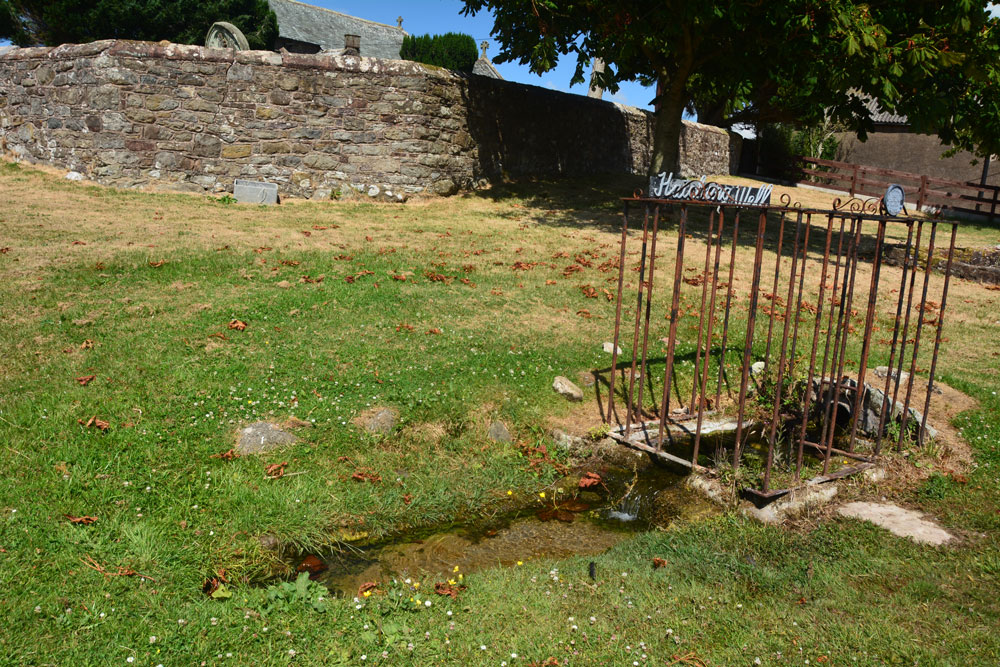
The Hatching Well (Gilcrux) submitted by Anne T on 10th Jul 2018. Standing just to the west of The Hatching Well, looking towards the southern boundary wall of St Mary's churchyard, just behind.
(View photo, vote or add a comment)
Log Text: The Hatching Well, Gilcrux: We arrived here and find this well bubbling away just outside the church - completely unexpected as it's not got any entries on Pastscape or Historic England. Neither is it mentioned in the Wikipedia entry for Gilcrux.
I guess finding this well made up for not being able to get into the church, which was very firmly locked and bolted, despite thinking we'd be able to get in. I'm trying to arrange with the vicar to go back mid-August to see AS Corpus Gilcrux 01.
Blennerhasset Cross
Trip No.81 Entry No.6 Date Added: 10th Jul 2018
Site Type: Ancient Cross
Country: England (Cumbria)
Visited: Yes on 9th Jul 2018. My rating: Condition 3 Ambience 4 Access 5
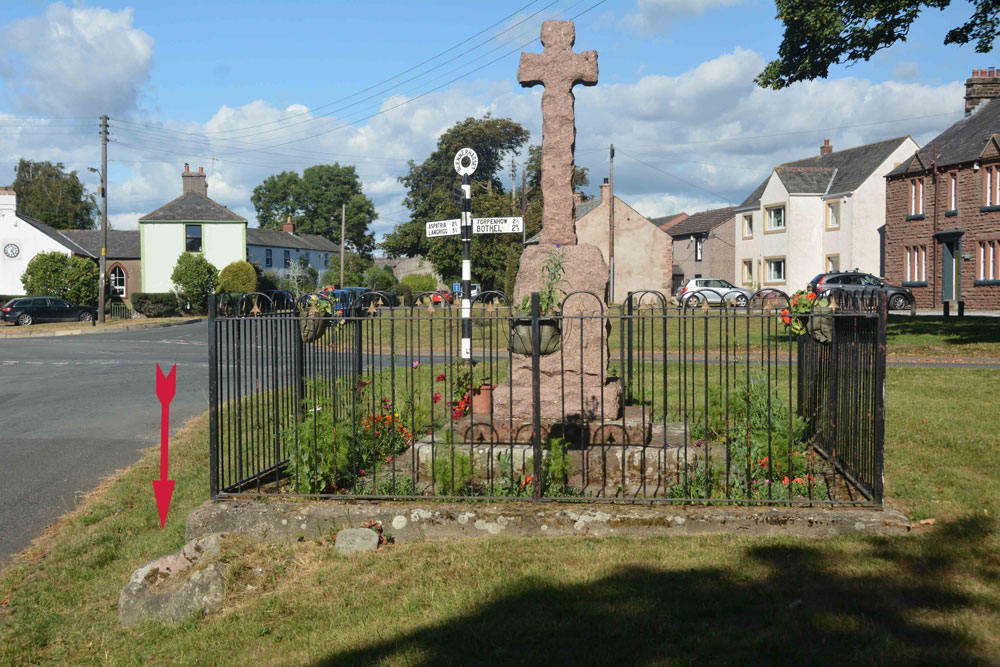
Blennerhasset Cross submitted by Anne T on 10th Jul 2018. The memorial, with discarded socket stone to the bottom left (highlighted by the red arrow), taken from the western side.
(View photo, vote or add a comment)
Log Text: Three crosses in one, Blennerhasset, Cumbria: Having been to four churches to see Anglo Saxon carved stones, and only found one unlocked, I wanted to stop and see the 'cross' marked on the OS map in this small village. This really is a stunning medieval village, and I wish we’d had more time to wander round and admire the old buildings. There was a lovely bridge over the river, although there was a children’s picnic and football match going on next to it, so we didn’t disturb them. There were two information boards outside the school, but neither mentioned the cross. Despite it looking like a war memorial, I wandered across only to find the base of the medieval cross and the discarded socket stone. Brilliant!
St Mary's Church (Wycliffe)
Trip No.80 Entry No.2 Date Added: 2nd Jul 2018
Site Type: Ancient Cross
Country: England (County Durham)
Visited: Yes on 1st Jul 2018. My rating: Condition 3 Ambience 4 Access 4

St Mary's Church (Wycliffe) submitted by Anne T on 2nd Jul 2018. Close up of the main face of the hog back sited to the west of the south door, inside the church. Recorded as AS Corpus Wycliffe 05, this hogback dates to the first half of the 10th century. The church guide says it is Danish and was dug up on the north side of the church, found at a depth of 4ft 6ins, in 1801. The Corpus says the panels contain the tops of interlace patterns, probably four-cord plait.
(View photo, vote or add a comment)
Log Text: Hogback and Anglo Danish/Saxon cross fragments, Wycliffe, County Durham: This is a spectacular little village, down a narrow, dead end lane leading to the River Tees. It was difficult to park, as the lane to the church has a sign saying ‘private road’ (although a sign also says ‘to the church’), so we bumped up on the verge, as close to a stone wall as we dared, leaving just enough room for another car to pass (everywhere else said ‘private’ or ‘no parking’.
Walking down the lane to the church, we approached from the north west, walking round to the south porch, which held a ‘welcome’ notice. A strange church – lovely, warm (but very worn) yellow sandstone, but no tower, just a couple of bells.
The main hogback fragment is just to the west of the south door, inside the church, with another fragment immediately opposite, and more against the western wall.
There is a really old Bishop’s chair against the north wall of the sanctuary, a Norman (11th century) font also against the north wall of the sanctuary and some really interesting 13th and 14th century glass.
When I got a phone signal, we realised we’d not seen the hogback fragment in the exterior southern wall, and as we were passing on our way back, went back to spot this and also found a boundary marker at the entrance to the churchyard.
Cleatlam Wayside Cross
Trip No.80 Entry No.1 Date Added: 2nd Jul 2018
Site Type: Ancient Cross
Country: England (County Durham)
Visited: Yes on 1st Jul 2018. My rating: Condition 2 Ambience 3 Access 5
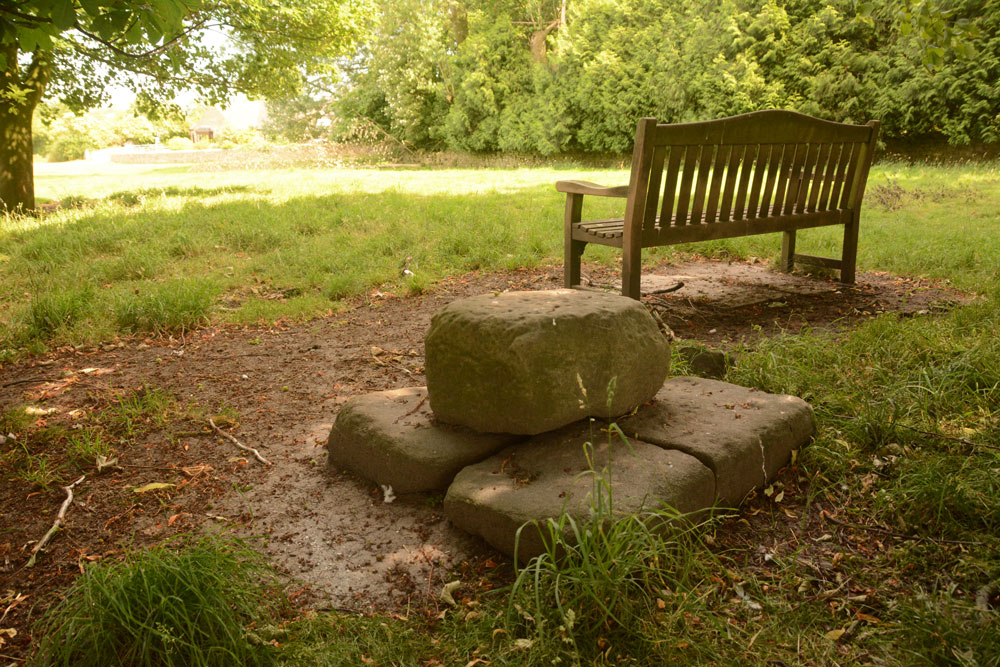
Cleatlam Wayside Cross submitted by Anne T on 2nd Jul 2018. First view of the cross base, approaching from the north and the minor road through the village.
(View photo, vote or add a comment)
Log Text: Cleatlam Wayside Cross, County Durham: This tiny village is picturesque, with large houses and farms on either side of the minor road through the village. The cross base wasn't easy to spot, hidden behind trees in a temporarily fenced off area of land, which looked like it used to be the old village green.
Sited just to the north of a wooden bench, the remains of this cross base is very odd. At first view, it looks to be a square block of stone split into two, but closer inspection reveals it is two separate pieces of stone embedded into the ground, with a smaller block placed on top.
Both Pastscape and HE say there is no socket hole, so presumably the cross would have been quite low and stood directly on top of this slab.
One of the strangest cross bases I've seen. In the field opposite, there are some interesting lumps and bumps, with a hollow way running almost parallel to the modern stone wall. Several housing/building platforms can be made out in the field. Pastscape attributes these earthworks to 'village shrinkage'.
The Shearers
Trip No.79 Entry No.2 Date Added: 2nd Jul 2018
Site Type: Stone Row / Alignment
Country: Scotland (Scottish Borders)
Visited: Yes on 27th Jun 2018. My rating: Condition 3 Ambience 4 Access 3
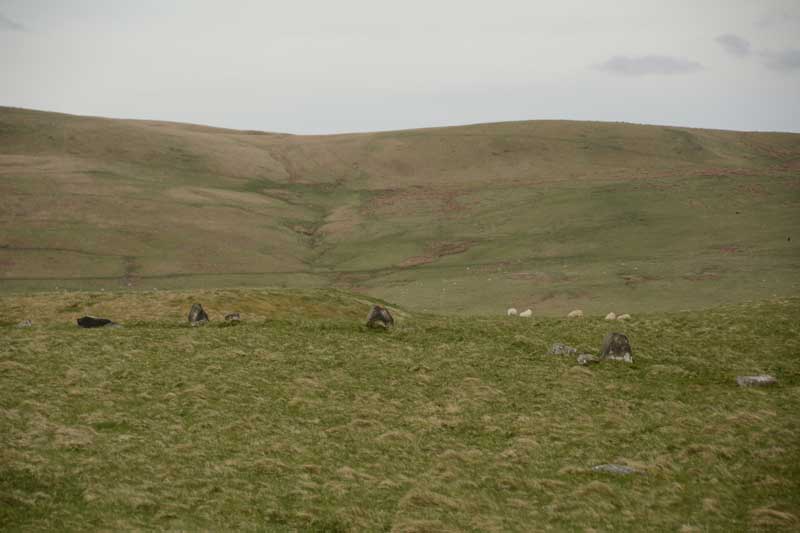
The Shearers submitted by Anne T on 8th May 2015. This was my first view of The Shearers, running across the centre/middle of the photograph from left to right.
(View photo, vote or add a comment)
Log Text: The Shearers, Hownam, Scottish Borders: By the time we got to the Shearers, the sun was high in the sky and beating down on us. Many horseflies, but thankfully no ticks. I was able to help with Sandy G's survey by acting as ‘the target’ for the disto (holding a piece of paper upright against the ranging pole so they could get accurate distances from the pole to each stone).
It occurred to me that where the row goes down the slope and ends at what is now a bog, at NT 7907 1927, perhaps this might have been a spring in ‘the olden days’ and been the water source for the hillfort.
The top end of the row seems to ‘bend’ slightly to the south east, heading towards looks like a hollowed out/partially excavated cairn.
It was fascinating to watch Sandy’s process of surveying the row, the row being too long to survey in one, so it was done in two halves. First he measured the distance of the centre of each stone from a ranging pole located in one spot, then took the angle of the stone from its central point to the ranging pole, transferring the measurements onto a plan, then photographed each stone individually. Finally, he walked up and down looking for ‘sighting lines’ – seeing what was visible from each stone, in which direction, and whether or not the stones echoed the shapes of any features in the landscape.
The conclusion Sandy came to (I think, as he says working out the details later will confirm or not) is that he counts this as a ‘possible’ stone row. It appears to be clearly associated with the nearby hill fort. I still dispute Canmore’s interpretation as the remains of a field boundary, as surely it would be connected to other old field boundaries nearby. None of these other boundary features had the earth removed from them.
We finally got back to the car at 6.30pm - the time had just flown. A very educational afternoon, and I was really pleased to have been involved in Sandy's survey. Pleasant day in pleasant company.
Horseshoe Wood (Hownam)
Trip No.79 Entry No.1 Date Added: 1st Jul 2018
Site Type: Standing Stone (Menhir)
Country: Scotland (Scottish Borders)
Visited: Yes on 27th Jun 2018. My rating: Condition 3 Ambience 4 Access 4

Horseshoe Wood (Hownam) submitted by Anne T on 8th May 2015. One of the broader faces of this enigmatic standing stone in its gloriously scenic setting.
(View photo, vote or add a comment)
Log Text: Horseshoe Wood Standing Stone: This was my first real 'day out' since being ill with flu and having been confined to bed for a week, so not feeling hugely great in myself, but great to be outside again. We met Sandy G (of Stone Rows of Great Britain fame) in Hownam Village and followed The Street, Sandy kindly moderating his pace to a slow 'plod' to accommodate me, until we reached Horseshoe Wood. The sun was bright and the temperature rose higher as we walked up the slope. I was glad to stop at the standing stone for a drink and to take some photographs. Great to hear Sandy’s views about the location of the stone and its context; it’s difficult to know what ages standing stones actually are, and whether they are in their original location. However, this one is placed right next to an important route, The Street, described as a ‘historic cross border route), which provides the context.
There is a quarry to the immediate east of the stone, which makes the location look a little suspicious, but the stone looks as if it is in its original location with packing stones around its base and on a low, oval mound.
St John The Baptist (Rolleston)
Trip No.78 Entry No.4 Date Added: 26th Jun 2018
Site Type: Ancient Cross
Country: England (Leicestershire and Rutland)
Visited: Yes on 24th Jun 2018. My rating: Condition 3 Ambience 3 Access 4

St John The Baptist (Rolleston) submitted by Anne T on 26th Jun 2018. Site in Leicestershire and Rutland England. The floriated cross head looks more modern than the worn capital underneath.
(View photo, vote or add a comment)
Log Text: Churchyard Cross, St John The Baptist, Rolleston: Apart from one sign post on the road by the church in Skeffington, this exclusive hamlet may well not exist. The road is gated (at least 3 gates), the roads are very narrow, and at the junction of the road and the bridlepath down to the church, there are a number of ‘no parking’ signs. This meant our daughter-in-law-to-be had to drop us off and drive some distance away, then collect us afterwards.
There is a small iron gate into the churchyard. This appears to be the only entrance, as the road at the eastern end of the church is labelled ‘private’. Eventually managing to open the gate into the church, we found the cross at the south eastern corner of the church, almost hidden in the shadows of the trees. It looked as if the owner of the modern house had incorporated this part of the churchyard into their private garden, so we very much felt like we were trespassing and expected someone to come out of the house and shout at us to ‘move on’.
Due to the heavy shadows and bright sunlight, it was a little difficult to photograph this cross. There appears to be a difference of opinion between Historic England and Pastscape as to the date of this cross – HE says 14th century; Pastscape 17th. The socket stone was marginally intriguing as it had a small hole in each side, presumably to drain any water away.
Making our way back along the gated road to civilisation, we stopped by the stream to let the dog paddle.
St Michael's Church (Illston On The Hill)
Trip No.78 Entry No.2 Date Added: 25th Jun 2018
Site Type: Ancient Cross
Country: England (Leicestershire and Rutland)
Visited: Yes on 24th Jun 2018. My rating: Condition 3 Ambience 4 Access 5

St Michael's Church (Illston On The Hill) submitted by Anne T on 25th Jun 2018. Close up of the socket stone and remains of cross shaft, looking towards the south porch from the southern edge of the churchyard, next to Main Street.
(View photo, vote or add a comment)
Log Text: St. Michael's Church, Illston on the Hill: This was our first port of call on the Sunday afternoon, on a brilliantly sunny day with blue skies and very hot. Although we probably could have walked here with the dog from Billesdon, I certainly wasn’t feeling up to a long walk today, and was very grateful that the cross was only just off the road.
A very pretty little church, which seemed larger on the inside than the out. The inside of the church wasn’t particularly interesting, apart from a very unusual set of steps that ran up to the top of the rood, from just behind the pulpit.
The cross was unusual, with the socket stone being set straight into the ground (no base or steps) and the remains of the cross shaft set diagonally into the socket. The shaft also had rolled-moulded edges. Also unusual was that it was set almost directly against three large gravestones which loomed above it.
King's Norton
Trip No.78 Entry No.3 Date Added: 25th Jun 2018
Site Type: Holy Well or Sacred Spring
Country: England (Leicestershire and Rutland)
Visited: Yes on 24th Jun 2018. My rating: Condition 3 Ambience 3 Access 5

King's Norton submitted by enkidu41 on 31st Aug 2004.
(View photo, vote or add a comment)
Log Text: Well, St John The Baptist, King's Norton: This is a very posh village, with very large houses. We parked by the tiny little village green just to the west of the church, almost next to the well, which is low down in the western churchyard wall.
Someone has been refurbishing the well, and recently, as there is a fresh footprint or two in the sand now forming the bottom of the well pool.
The church is relatively modern, a plaque next to the gate describing it as ‘Georgian Gothic’. The churchyard is relatively small, and not much to see in it, apart from a huge memorial right up against the exterior eastern wall. The church itself was locked, although a name/phone number was given to collect the keys from, but we weren’t interested enough to go inside.
Pastscape describes this well as a ‘horsetrough’. Whilst the well was very dry at the time of our visit, there is no sign within the churchyard (or the neighbouring house) as to where the source of the water comes from, although the top of the ground is at least 2m higher behind the well.
Milfield Reconstructed Henge at Maelmin Heritage Centre
Trip No.77 Entry No.1 Date Added: 1st Jun 2018
Site Type: Henge
Country: England (Northumberland)
Visited: Yes on 31st May 2018. My rating: Condition 4 Ambience 4 Access 4
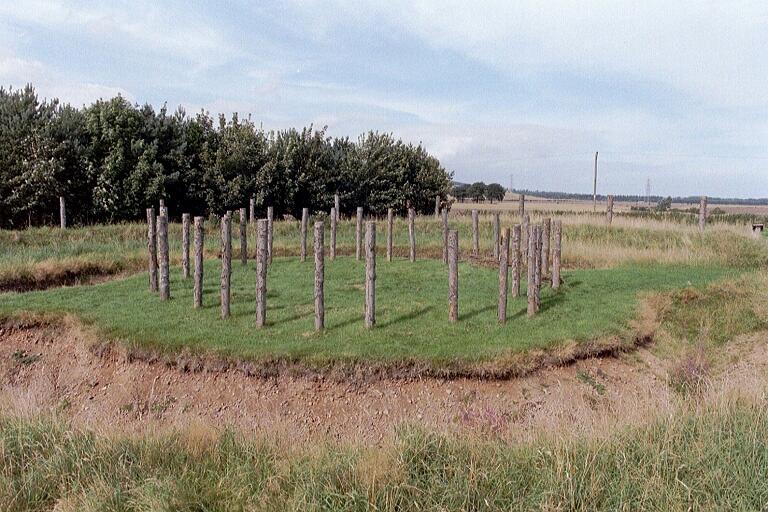
Milfield Reconstructed Henge at Maelmin Heritage Centre submitted by Andy B on 27th Feb 2003. Part of the Burnham family trip to Northumberland, August 2002
(View photo, vote or add a comment)
Log Text: Maelmin Recreated Henge, Milfield: We had a bit of a tortuous journey to get here, having been stuck in roadworks on the A1 northbound, so instead of the hour and a half it would have taken us, it was almost two and a half, so we were eager to get out of the car and walk.
Having found the ‘Archaeological Guide’ by Clive Waddington in a local charity shop about 10 days ago, I had read it from cover to cover and was really keen to see this site. I’d shown the booklet to our three year (going on 63) old grand-daughter and we’d talked through the photos on the journey here. As we walked into the centre of the henge from the car park, she turned to me and, pulling a face, said; “It’s just a ‘thing’ with a deep hole”.
Having spotted all the information boards round the site and running through the woods, she ran from one to the other. On getting to the Dark Age hut at the far side of the site, she was fascinated by this, and we had to go inside. Opening the door was amusing, at the wood had swollen in the rain and it took a while to get it to swing open gently without trapping fingers.
We walked back around to the henge following the circular path around the field, taking in the airfield. We found a sign saying ‘Mesolithic hut’ but there was only a hollow in the ground with a few poles laid inside.
No totem poles, or none that we could spot, anyway. It looks like these have now been replaced with two taller plain tree trunks.
After reading the story of the recreation of the henge, I did enjoy seeing it but had expected more from the heritage trail, which was essentially a ‘trail’ of information boards but without any real specific context or associated feature to look at. Would go again, without dearly loved child, to soak in the atmosphere. We went onto the Heatherslaw Light Railway - a great 15in gauge railway, ideal for small children and grandparents!
Netherwitton A
Trip No.76 Entry No.4 Date Added: 28th May 2018
Site Type: Round Cairn
Country: England (Northumberland)
Visited: Yes on 26th May 2018. My rating: Condition 3 Ambience 4 Access 4

Netherwitton A submitted by Anne T on 28th May 2018. This photo is three stitched together and shows the southern edge of the cairn, with its stony structure.
(View photo, vote or add a comment)
Log Text: Netherwitton Round Cairn A: This cairn is clearly visible from both Five Ashes cairn and Netherwitton B. There were some magnificent sheep and lambs in this field, all seemingly oblivious to the ancient monument underneath their hooves. All of them scattered as we approached the cairn. My first impression was ‘how many tens of thousands of stones did they use to create this cairn?’; the second ‘the interior has certainly been hacked about by whoever excavated this’.
We walked all round the higher outer bank of the cairn – it’s big. A very pleasant walk, to see three Bronze Age cairns very close to each other. This must have been a thriving community back in the day, especially with the River Font to the east and the Ewesley Burn to the west. I would have expected a standing stone or two to be in this area – it’s very fertile farmland here.
Netherwitton Hall
Trip No.76 Entry No.5 Date Added: 28th May 2018
Site Type: Round Cairn
Country: England (Northumberland)
Visited: Yes on 26th May 2018. My rating: Condition 2 Ambience 2 Access 5
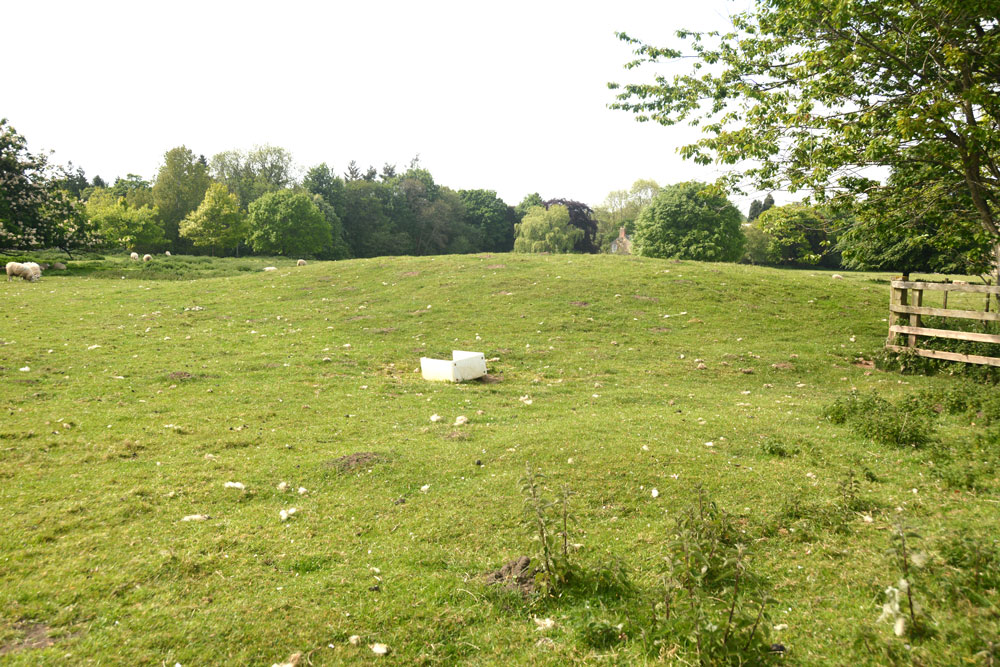
Netherwitton Hall submitted by Anne T on 28th May 2018. The mound or possible round barrow by Netherwitton Hall looks like an undisturbed barrow. The gate into the field was tied with a series of 'Gordian knots', and not being terribly excited by this mound, I photographed it from the gate.
(View photo, vote or add a comment)
Log Text: Round Cairn near Netherwitton Hall: Pulling up by the side of the road, taking the spot of a car that had just driven off northwards, this field was chock full of sheep and lambs, with the gate tightly tied with string in a ‘gordian knot’. Usually, I’d spent time untying the string, but as the mound didn’t look very exciting, I photographed it through the gate. Whilst it’s recorded on the OS map as a cairn, both HE and Pastscape wonder if this is actually a cairn or not, even though it’s scheduled as a round barrow.
Netherwitton B
Trip No.76 Entry No.3 Date Added: 28th May 2018
Site Type: Round Cairn
Country: England (Northumberland)
Visited: Yes on 26th May 2018. My rating: Condition 3 Ambience 4 Access 4
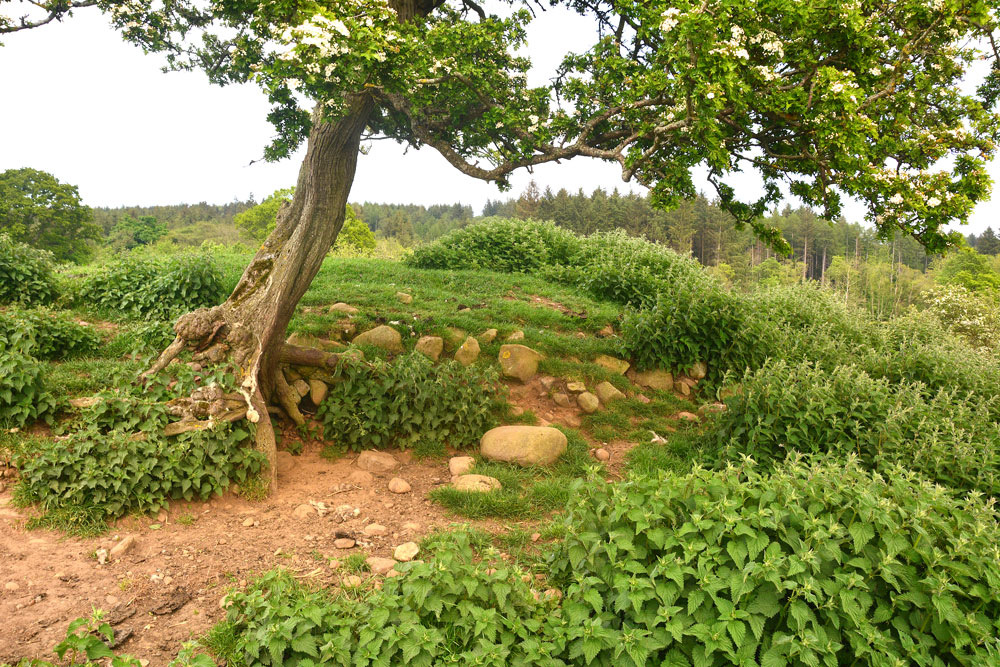
Netherwitton B submitted by Anne T on 28th May 2018. The internal structure of the cairn can be seen more clearly on its south western side, where a hawthorn tree has grown up from the base, and animal sheltering under it have rubbed away the surrounding earth.
(View photo, vote or add a comment)
Log Text: Netherwitton Round Cairn B: This cairn is located in a really lovely spot, on what was a small promontory, one side forming an old bank of the River Font, the river having changed course many years ago. We walked past this without realising this was the second cairn on the map, both saying: “That looks distinctly like a cairn”, then realising after I’d photographed it that it was the second Bronze Age cairn mentioned on Pastscape. Whilst small, it's a really nice example of a cairn, and the internal structure can be seen where a hawthorn tree grows out of its south west side, and animals have rubbed the earth away. This cairn has been apparently undisturbed by the antiquarians. I wonder why? Curious.
Clavering's Cross
Trip No.76 Entry No.5 Date Added: 28th May 2018
Site Type: Ancient Cross
Country: England (Northumberland)
Visited: Yes on 26th May 2018. My rating: Condition 3 Ambience 4 Access 4
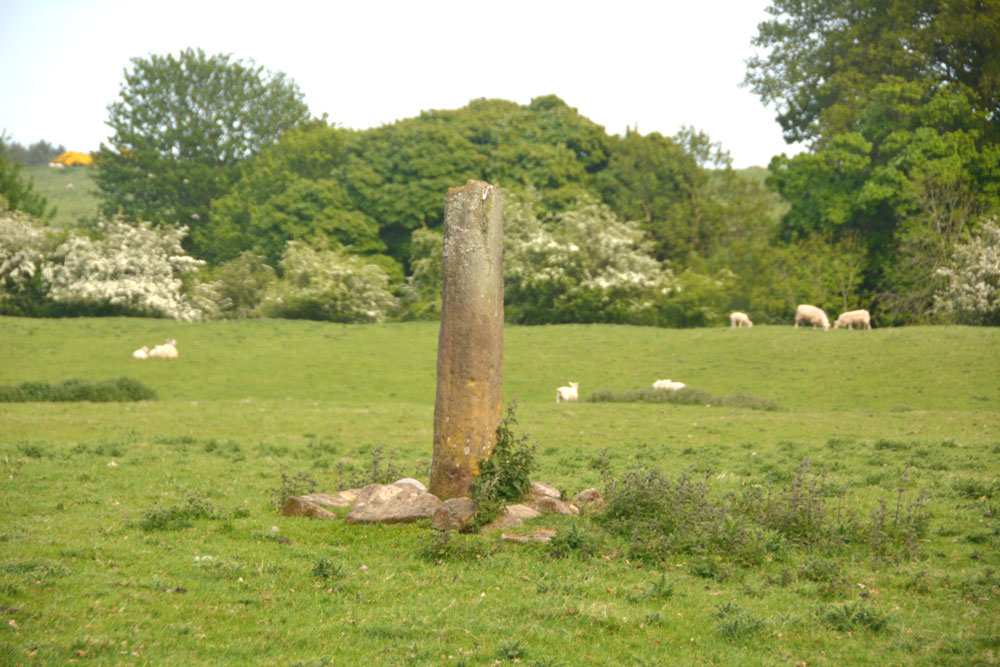
Clavering's Cross submitted by Anne T on 28th May 2018. Getting close, approaching from the north west, the fracture at the top of the cross shaft is clearly visible. Is the cross head really in the dike at the west side of this field??
(View photo, vote or add a comment)
Log Text: Clavering's Cross, Stanton: Disappointed by the third cairn, which we were really unsure of, I’d spotted this cross on the OS map, and as it wasn’t too far away, we thought we go on our way to Ewesley.
Parking on the verge just north of the farmhouse, there were roadworks being set up and a very large, yellow skip had been placed by the gate into the field. As there was a large ditch to its south, there was a very narrow piece of land to walk across, and with the side of the skip looming above my left hand side, I managed the two steps across, because I really wanted to see this cross.
We had to shoo the lovely, fat hens out of the way to open the gate, and spent a few minutes walking round and taking photographs. The steps were in a sorry state, which is unusual - Pastscape tells us the cross has (within living memory) been relocated back to the site where it originally stood, so perhaps the steps weren't built properly during the relocation.
Ewesley Enclosure
Trip No.76 Entry No.6 Date Added: 27th May 2018
Site Type: Misc. Earthwork
Country: England (Northumberland)
Visited: Yes on 26th May 2018. My rating: Condition 2 Ambience 4 Access 4
Ewesley Enclosure submitted by SolarMegalith on 16th Jun 2013. Bank and ditch in the western part of the probable Iron Age enclosure (photo taken on June 2013).
(View photo, vote or add a comment)
Log Text: Ewesley Defended Settlement, Northumberland: This was our last stop of the day, and it was really warm. There is a permissive footpath which runs along the dismantled railway line, although we drove past and had to retrace our steps to find it. The footpath sign is on a gate at approx.. NZ 05932 92605, just south of the railway bridge, and a small bridge over a stream, on the B642, before the farm to the north of the bridge.
Be warned, as the ‘footpath’ is really non-existent, and if we’d have strayed off the higher ground, we’d have needed waders to cross certain parts. As it was, we found an old boundary bank running north-south across a fence line and followed that to the drier side on the other side of a burn/drainage ditch.
The southern part of the structure can be clearly seen from the road, and it’s clearly a settlement of some kind, although why it’s southern been built on a slope, I’m not sure. There is an outer bank and ditch, which we followed up to where the settlement is cut by the railway line, and we found the easiest way down and across, up to its northern side, where some of the inner banks remain.
This is certainly a settlement of some kind; we couldn’t reconcile ourselves to it being a henge. Certainly enigmatic..
Five Ashes Cairn (Netherwitton)
Trip No.76 Entry No.1 Date Added: 27th May 2018
Site Type: Round Cairn
Country: England (Northumberland)
Visited: Yes on 26th May 2018. My rating: Condition 2 Ambience 4 Access 4
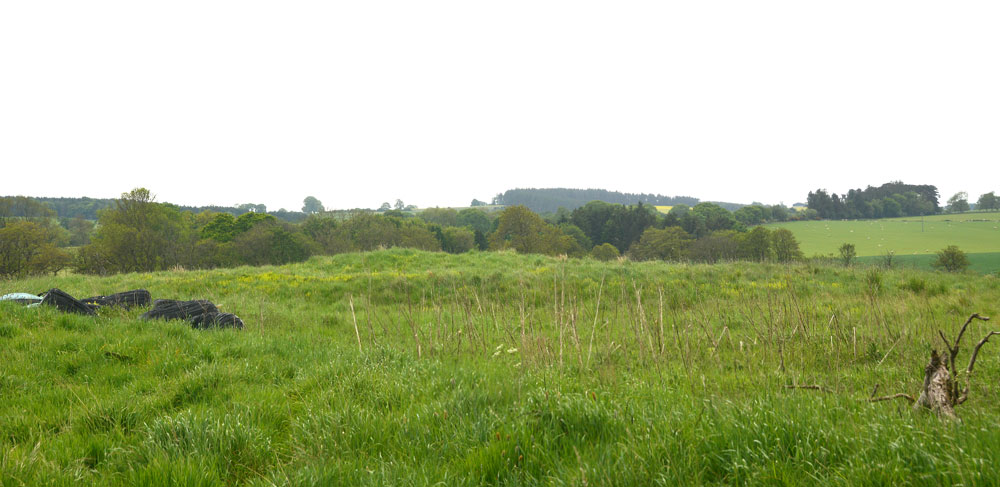
Five Ashes Cairn (Netherwitton) submitted by Anne T on 27th May 2018. First proper view of the Five Ashes Cairn from the gate into the field at approximately NZ 09596 90631. It is located on a slight rise in the landscape. The farmer has kept the area of, and just around the cairn, free of crops.
(View photo, vote or add a comment)
Log Text: Five Ashes Cairn, Netherwitton: From St. Giles’s Church, we drove back through Netherwitton, taking the right hand turn which runs northwards, to the west of the meandering River Font. Parking at NZ 09891 90457, next to the entrance to the field with the footpath running through, we set off across the mowed footpath. This section of shorter grass petered out after about 100metres. Five Ashes Cairn was visible to our west after about 300metres. There was a gate into the cairn field, technically trespassing, but the area with, and around, the cairn, had been left clear of crops, so we kept to the field edge and made our way the 50m or so across to the cairn.
At this time, a whole ribbon of small planes began to fly across, one at a time, about 30 seconds apart. I lost count after 20, then came the hang gliders and microlights, the some more small planes. They were all heading roughly from north east to south west, and we haven’t been able to find out where they came from, or where they were going to, although the Borders Gliding Club isn’t that far away from this location, near Milfield and Maelmin.
If we hadn’t have known this what we were looking at, and that it was marked on the OS map, anyone could have been forgiven for thinking this was just a farmer’s mound/junk heap with straw bales and other items left on its north eastern side.
This cairn looked quite large, with a steeper bank on its western side. It looks as if it has been crudely excavated, with various lumps and bumps under the long, tussocky grass (and lots of short, fierce nettles at ankle level!) over the mound.
St Maurice's Well (Ellingham)
Trip No.75 Entry No.5 Date Added: 22nd May 2018
Site Type: Holy Well or Sacred Spring
Country: England (Northumberland)
Visited: Yes on 20th May 2018. My rating: Condition -1 Ambience 4 Access 4
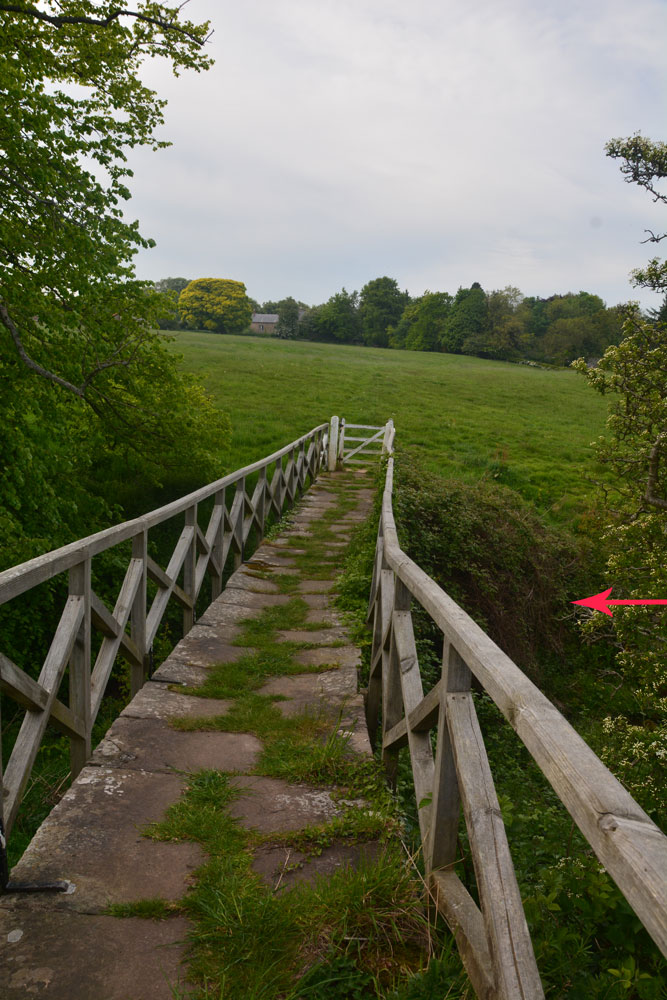
St Maurice's Well (Ellingham) submitted by Anne T on 22nd May 2018. We think this was the site of St. Maurice's Well, just to the south western side of this charming stone-flagged footbridge across the Long Nanny.
(View photo, vote or add a comment)
Log Text: St. Maurice's Well, Ellingham (destroyed): This church was in a glorious spot amongst old houses. The church looked relatively modern, and as it was still open, we popped our heads in. There was some really great stained glass windows. They also had a book sale, so we bought a couple of books on cathedral architecture for a £2 donation.
Inside, we spotted the head of an old font, dating (according to the church guide) to the Norman or Early English Church (but looked 16th/17th century in style to me). On either side of the path from the lych gate to the church were the old pinnacles from the previous church, dating to 1805.
Finding the right footpath from the church proved interesting, as it had a number of footpaths running from/around it, but we eventually orientated ourselves. Back to the Long Nanny stream.
From the description, we found the footbridge and the gorge/bank, but couldn’t really find any structures. I asked a lady (about 40ish) walking her dog if she knew where the well was. She replied “They used to come from the school to get the water. There used to be steps, but they’re gone, and no-one knows where the well was. It’s lost.”
We tried to find the location, which needed to be in a slight ravine (hence the reference to steps), and any old stonework. We thought we might have spotted something. But, then again, perhaps not! It was worth it to see the wonderful stone-flagged footbridge.
St Ebba's Chapel
Trip No.75 Entry No.4 Date Added: 22nd May 2018
Site Type: Ancient Cross
Country: England (Northumberland)
Visited: Yes on 20th May 2018. My rating: Condition 2 Ambience 4 Access 4
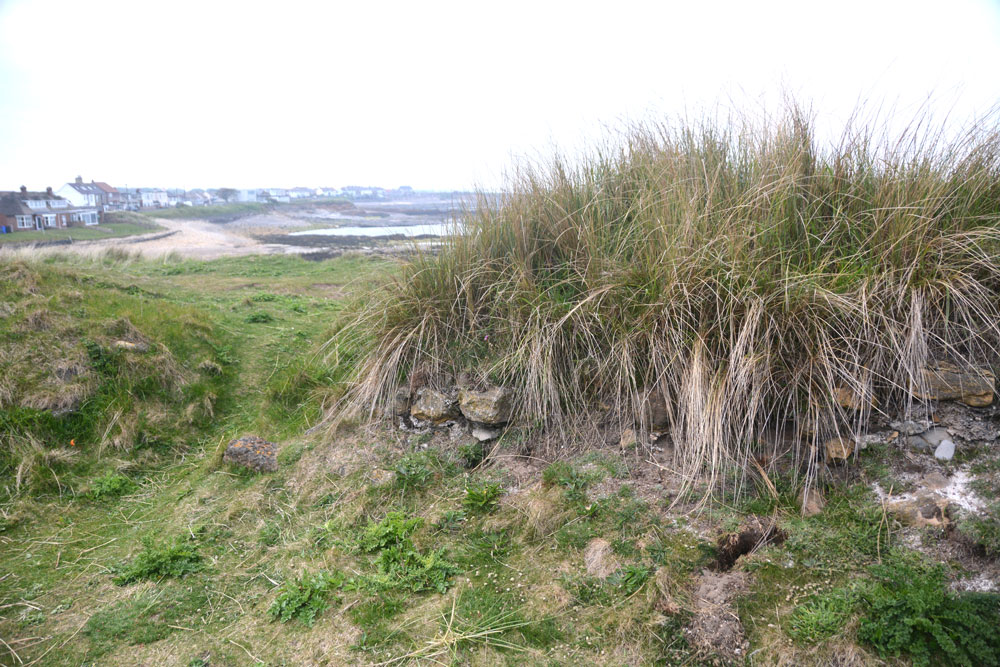
St Ebba's Chapel submitted by Anne T on 22nd May 2018. Inside the ruins of the chapel, looking at the northern doorway and remains of the northern wall.
(View photo, vote or add a comment)
Log Text: St Ebba's Chapel/Early Christian Monastery site: I have long wanted to come to this spot, ever since seeing the Time Team Excavation of this in July 2013. Whilst the rest of Northumberland had a hot day with blue, cloudless skies, this part of the coast was murky. Still, this was a very enigmatic place.
We’d stopped off at a café/restaurant in Beadnell village for refreshments before arriving here, and I’d looked at their guide book “Limekilns and Lobsterpots” before arriving, which intrigued me further.
A lonely spot, largely surrounded by sea on a narrow promontory. I wish I’d been able to see the excavations, but found the Wessex Archaeology report.
Tughall Chapel
Trip No.75 Entry No.3 Date Added: 22nd May 2018
Site Type: Ancient Cross
Country: England (Northumberland)
Visited: Yes on 20th May 2018. My rating: Condition 2 Ambience 4 Access 4
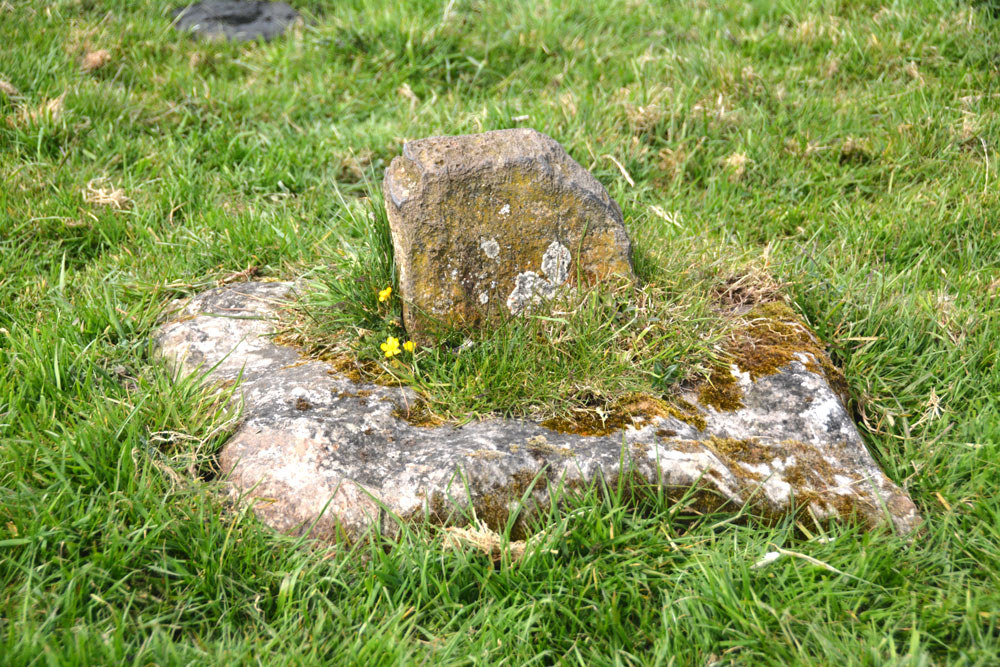
Tughall Chapel submitted by Anne T on 22nd May 2018. The socket stone and fragment of cross shaft from a different angle.
(View photo, vote or add a comment)
Log Text: Socket stone and cross shaft fragment, Tughall: Continuing along the busy B1340 from the Long Nanny standing stone, we turned right off the road towards Tughall Farm. There, the remains of the chapel stood above the road. We parked at a small layby just off the main road at NU 21427 26478, where there was a small gate into the field. This had been wired shut, so we walked round to the main gate at NU 21224 26486. There was absolutely no-one around to ask, and as the cattle were at the far end of the field, we let ourselves in.
The chapel is raised above the surrounding land. Only the tiniest bit of masonry remains (part of the apse, according to HE). The cross base is to the south of the chapel, almost next to what we initially thought might have been a hogback, but is only an old grave stone. I couldn’t see any writing on it.
The portion of cross shaft fragment remaining in the socket stone is very small and thin. I wonder what happened to the rest of it? [Note, this is on private land, but we didn't find anyone around in all the buildings on the farm to ask if we could take a look.]
Next stop, but not recorded on the Portal, was the lime kilns and harbour at Beadnell (too recent in time!)
St Hilda's Church (Lucker)
Trip No.75 Entry No.1 Date Added: 21st May 2018
Site Type: Ancient Cross
Country: England (Northumberland)
Visited: Yes on 20th May 2018. My rating: Condition 2 Ambience 3 Access 4

St Hilda's Church (Lucker) submitted by Anne T on 21st May 2018. The cross base is nestled under trees and brambles, next to the grave of a lady called "Janet". This part of the graveyard has been neglected over a number of years. We thought the church might have made more of their socket stone.
(View photo, vote or add a comment)
Log Text: Cross base, St. Hilda's Church, Lucker: We had a walk around the churchyard, but were unable to find a cross base amongst the gravestones. We wandered down as far as the river, Waren Burn, which flowed to the east of the church. Not finding anything, we wandered into the church. There was no guide book, but there were laminated sheets detailing the history of the church and St. Hilda, which I photographed.
Having found the cross base on Pastscape, with the grid reference, I was very reluctant to give up the search. It did indeed take some finding, as it was completely buried under ivy in a very overgrown section of the churchyard. Typically, not having the gps with us when we needed it, common sense said that the cross base should ideally be at the eastern end of the church at the highest point of land before it started to drop down to the river below. I had to clamber over brambles and force my way through trees to get to this part of the churchyard. The cross base was next to the grave of a lady called ‘Janet’.
